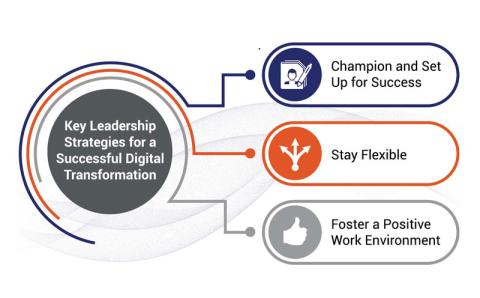
The Top 3 Strategies Every Leader Needs for a Successful Digital Transformation
Christine Cocrane Performance Optimization, Digital Transformation Technologies, Strategic Planning, Innovation at LMI
It’s undeniable: digital transformations are here to stay. They are quintessential drivers for change in organizations, and they are expanding in number and accelerating in frequency at breakneck speed. The demands of a world in which digital transformations prevail require us as leaders to stand up and take notice, regardless of our mission or our customers. We all operate in this new and uniquely complex environment and need new ways to think about—and lead—digital transformations.

Successful organizational change depends on leaders who can inspire innovation, create digital strategies, understand and lead an agile team, and leverage the power of standing-up new technology solutions while managing risks. Change affects every sector within our organizations, from our workforce to our business models and from our culture and the way we communicate to the way we deliver on the user experience. From our process to our approach to performance and beyond, digital transformations call for a holistic view of what we do and why we do it.
Here are three main strategies and steps to guide your digital transformation journey:
1. Champion and Set Up for Success
- Create a shared vision: Digital transformations often start strong at the top but lose momentum as they cascade to the frontline. As leaders, we need to translate our business case for change into a vision others can “see”—a future view that resonates with everyone across our organization so they can use it as a blueprint to power forward throughout the transformation process. Start with your vision; it will be your north star.
- Engage your team: Give your team a clear vision of the end-result; discuss why the organization is pursuing digital transformation and why now. Use examples of success stories to spark enthusiasm about the future. Without purpose and excitement, digital initiatives (and enthusiasm for them) will quickly fizzle. Explain the benefits to your organization and to team members. Invite input from staff members and let each know their contribution is vital. Build rewards systems to encourage urgency for staying on track and to express to employees how valued they are throughout the transition.
- Train your team: At all levels, equip your teams to handle the upcoming change. Empower your senior staff members to serve as your digital transformation champions. Leverage their expertise and help them mobilize their teams. Set up performance metrics, track key performance indicators, emphasize learning, and stay engaged throughout the entire project lifecycle.
- Communicate: As leaders, we are the face and the voice of change. We must communicate the right information and the right message at the right time and in terms everybody can understand. Share your perspective. Offer encouragement. Model transparency. Talk to people.
- Put customers first: Your internal and external customers matter. Create forums to seek feedback and to share your vision for the future. How our customers perceive and experience the changes we plan and implement is priceless data we can use to keep on course (and course correct when necessary). Remember, “agile” is not just a way of “doing” digital transformations, it is also a way of leading them. The user experience is at the core of what we seek to serve.
2. Stay Flexible
- Promote an adaptive culture: Encourage colleagues to be open to receiving user feedback so they can adjust the change plan along the way. Emphasize learning. Share the “big picture,” but don’t forget to remind people at all levels “what’s in it for them.” Demonstrate a willingness to engage with complexity and ambiguity. Initiate conversations about the challenges this mindset presents and invite people—in person and virtually—to talk about what is challenging them.
- Test impacts and alignments: Pilot cases with your colleagues and have open discussions related to changes in business processes that inevitably result from a digital transformation. Digital transformation doesn’t just involve IT or operations; it mobilizes multiple teams to work collaboratively to innovate and create change.
- Leverage Feedback: Create forums for input and enable people to express resistance without reprisal. Doing so helps build organizational resilience, helps mitigate risks, and increases your ability to respond and pivot, if needed.
- Focus on outcomes: Align the transformation process to follow business strategies by holding regular check-ins to stay on track. Collaborate on setting performance goals. Emphasize knowledge sharing and communication across organizational “silos.” Configure multi-functional teams to tackle emerging challenges. Applaud staff members’ efforts. Share the results broadly. Tie what they are doing to your overall strategic imperatives and to customer impact.
3. Foster a Positive Work Environment
- Manage resistance: Human resistance to change can be a big obstacle to adoption during a digital transformation. Leading change means anticipating and embracing resistance as part of the change process. Listen to what your resisters are saying and seek to understand their perspectives. Often, you’ll find they have a great idea and even more often you’ll find they are raising concerns that need to be heard.
- Consider the psychology of change: Look to change experts who can help you and your team understand human behavior during times of change and stress. Remember, organizations don’t change; it’s the people in them who change.
- Be open, keep scanning: Be proactive. Continuously assess. Ask questions and listen to the answers. Conduct regular check-ins. As leaders, we need to look at our organizations as living, breathing entities where a change in one sector can affect multiple other sectors. When you build leadership agility and change capability across your organization, your digital transformations will thrive.
Transformations rarely go exactly as planned. Building digital capabilities is one of the top priorities in any executive’s agenda—and for good reason. Not only are resources at stake, but so is your organization’s ability to stay ahead and remain profitable in an increasingly competitive market. Adapting to a digital transformation always comes with hurdles, particularly when technology continually reshapes the boundaries of what is possible.
It can be even more difficult to motivate employees and ensure they are ready for transformative changes. Use all your tools to inspire your team so they can successfully lean into the agile principles and mindset. Leaders using a systematic approach to take advantage of new opportunities, will win the battle of the future. A growth mindset, strategic communication and influence, the ability to navigate innovation and change, and effective collaboration will push us to the next level and future-proof your organization.
Leaders using a systematic approach to take advantage of new opportunities, will win the battle of the future.


Christine Cocrane
Sr. Vice President, Management Advisory ServicesChristine (Chrissy) leads a dynamic practice of human, programmatic, scientific, and technological management consulting professionals.


